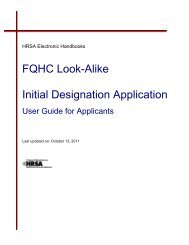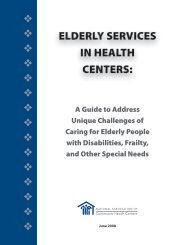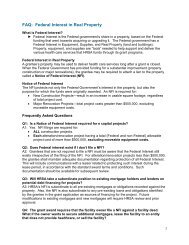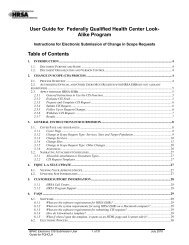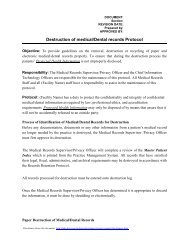Sample Board of Directors Governance Policy Manual - Bureau of ...
Sample Board of Directors Governance Policy Manual - Bureau of ...
Sample Board of Directors Governance Policy Manual - Bureau of ...
Create successful ePaper yourself
Turn your PDF publications into a flip-book with our unique Google optimized e-Paper software.
Sumter Family Health CenterBOARD OF DIRECTORS’GOVERNANCE POLICY MANUALApproved by the <strong>Board</strong> <strong>of</strong> <strong>Directors</strong>: May 19, 2004
Amended by the <strong>Board</strong> <strong>of</strong> <strong>Directors</strong>: March 22, 2005Disclaimer about this document http://bphc.hrsa.gov/technicalassistance/resourcecenter/disclaimers.htmlTABLE OF CONTENTSIntroduction……………………………………………………………. 3Mission Statement/Commitments……………………………………...4Culturally Competent Organization…………………………………… 5Role <strong>of</strong> the <strong>Board</strong> <strong>of</strong> <strong>Directors</strong>………………………………………….6Job Description and Responsibilities………………………………….. 7Size and Composition…………………………………………………. 8Commitments………………………………………………………….. 9Training and Development……………………………………………. 12Committees……………………………………………………………. 14Standing Committees………………………………………………….. 15Officer Roles…………………………………………………………... 16Meeting Structure and Logistics………………………………………. 18<strong>Board</strong> Member Liability………………………………………………. 22Director’s Liability……………………………………………………. 23Appendix I (<strong>Board</strong> Member Position Description)…………………… 24Who Does What in Healthcare Operations…………………………… 25What Does the <strong>Board</strong> <strong>of</strong> <strong>Directors</strong>’ Do? …............................................ 27What Does the Executive Director Do? .................................................29Division <strong>of</strong> Responsibilities…………………………………………… 302
INTRODUCTIONThe Sumter Family Health Center (“Center”) <strong>Board</strong> <strong>Governance</strong> <strong>Policy</strong> <strong>Manual</strong> defines the role<strong>of</strong> the <strong>Board</strong> and delineates how the <strong>Board</strong> will carry out its responsibilities. The <strong>Board</strong><strong>Governance</strong> <strong>Policy</strong> <strong>Manual</strong> and the Bylaws are the primary governing documents for the Center.The purpose <strong>of</strong> the policies is to:• make clear <strong>Board</strong> intent, goals, and aspirations• promote consistency <strong>of</strong> <strong>Board</strong> action• clarify <strong>Board</strong> member’s roles, responsibilities, and commitmentsThe <strong>Board</strong> <strong>Governance</strong> <strong>Policy</strong> <strong>Manual</strong> is available at each <strong>Board</strong> meeting and provides guidancefor decision making. A copy <strong>of</strong> the <strong>Board</strong> <strong>Governance</strong> <strong>Policy</strong> <strong>Manual</strong> will be given to each<strong>Board</strong> member and revisions will be distributed, as appropriate.<strong>Board</strong> policies are adopted through a majority vote <strong>of</strong> the <strong>Board</strong> and only at <strong>Board</strong> meetings.Before adopting any policy, all <strong>Board</strong> members will receive a copy <strong>of</strong> the proposed policy inadvance <strong>of</strong> the meeting at which the vote is to be taken. All policies will be reviewed annuallyby the <strong>Board</strong> for accuracy and appropriateness, and recommendations will be made foramendment, addition, or elimination.3
MISSION STATEMENTSumter Family Health Center is a comprehensive primary healthcare practice dedicated to building a healthy community andimproving the individual health, well-being, and quality <strong>of</strong> life <strong>of</strong>each person we serve.We are committed to:• Being the health care provider <strong>of</strong> choice for people <strong>of</strong> all ages• Providing high-quality care in a patient focused manner• Equipping our patients with the knowledge, ability, andmotivation to make health choices and live healthy lives.• Eliminating barriers caused by financial circumstances orsocial situations that may prevent people from having access tohealth care.• Continually improving the quality <strong>of</strong> care and service weprovide.4
CULTURALLY COMPETENT ORGANIZATIONThe Center strives to be a culturally competent organization that accepts and respects individualdifferences. Diversity within the organization provides the Center with a full range <strong>of</strong>perspectives and contributes to the ability to better meet the needs <strong>of</strong> the diverse community weserve.The Center’s commitment will be reflected through an environment that not only promotes theawareness <strong>of</strong> ethnic, cultural, racial, economic, sexual orientation and gender issues, but alsovalues diversity. The Center will provide quality primary health care services without regard to aperson’s culture, ethnicity, economic status, sexual orientation, gender or ability to pay. Torealize this goal, The Center will train staff to be culturally sensitive, and actively recruit and hireculturally diverse staff. In addition, The Center will actively recruit <strong>Board</strong> members whorepresent the diverse community.5
‣ maintaining fiscal health and availability <strong>of</strong> resources‣ evaluating Executive Director’s effectivenessJOB DESCRIPTION AND RESPONSIBILITIESThe <strong>Board</strong> serves as <strong>Directors</strong> <strong>of</strong> the Center. The <strong>Board</strong> guides to act in the public interestand meet the needs <strong>of</strong> the community. The <strong>Board</strong> is responsible for:• Establishing goals and monitoring outcomes <strong>of</strong> the organization• Monitoring the organizational performance in fulfilling the mission <strong>of</strong> the center• Assuring the center has the necessary resources and is fiscally healthyThe Department <strong>of</strong> Health and Human Services’ (DHHS), Health Resources and ServicesAdministration’s (HRSA), <strong>Bureau</strong> <strong>of</strong> Primary Health Care (BPHC) provides oversight <strong>of</strong> theCenter’s Federal 330 grant. As defined within Health Center Program Requirements (seehttp://www.bphc.hrsa.gov/about/requirements/index.html for further detail), the <strong>Board</strong> <strong>of</strong><strong>Directors</strong> has the responsibility for establishing policies, including but not limited to:• Approval for the selection and dismissal <strong>of</strong> the Executive Director (ED)• Review the performance <strong>of</strong> the ED• Establishing operating policies including human resources and financial managementpolicies• Establishing health care policies including scope and availability <strong>of</strong> services, location andhours <strong>of</strong> services• Assuring the Corporation is operating in compliance with federal, state, and local lawsand regulations• Evaluating healthcare activities <strong>of</strong> the Corporation, including but not limited to providerproductivity and recruitment and retention.‣ Guidelines defined in The Recruitment and Retention <strong>Manual</strong> <strong>of</strong> the NationalRural Recruitment and Retention Network, Inc., provided in conjunction with theSouth Carolina Office <strong>of</strong> Rural Health, will be utilized as an action plan ifappropriate.7
The <strong>Board</strong> <strong>of</strong> <strong>Directors</strong> will perform a self-evaluation <strong>of</strong> <strong>Board</strong> operations on an annualbasis. The <strong>Board</strong> will use the results to identify problems and set goals for improvement.SIZE AND COMPOSITIONAccording to Section 3.02 <strong>of</strong> the Center’s bylaws, “The Corporation shall have no fewer thannine (9) and no more than twenty-five (25) <strong>Directors</strong>.” The <strong>Board</strong> will be diverse in itsrepresentation by gender, race, ethnicity, and pr<strong>of</strong>ession. In addition, <strong>Board</strong> members will berecruited from different geographic regions <strong>of</strong> the service area.User <strong>Board</strong> Members:• At least 51% <strong>of</strong> the <strong>Board</strong> members will be recipients <strong>of</strong> services at the Center.User <strong>Board</strong> members will be defined as those who have used the services <strong>of</strong> the Center inthe past two years and consider the Center as their principal source <strong>of</strong> primary healthcare.• User members will be reflective <strong>of</strong> the population served by the Center in terms <strong>of</strong> race,ethnicity, and sex. The determination will be made by reviewing the Center’s annualUniform Data System (UDS) report.Non-User <strong>Board</strong> Members:• The remaining members <strong>of</strong> the <strong>Board</strong> <strong>of</strong> <strong>Directors</strong> will be representative <strong>of</strong> thecommunity primarily served by the practice location <strong>of</strong> the Center.• Non-User <strong>Board</strong> members will be selected for their expertise in community affairs, localgovernment, education, medicine, finance and banking, legal affairs, business, and socialservices.• No more than one-half <strong>of</strong> the non-user <strong>Board</strong> members will be individuals who areemployed in healthcare and therefore derive more than 10% <strong>of</strong> their annual income fromthe health care industry.• There will be provider representation on the <strong>Board</strong>.Elections:8
• <strong>Board</strong> composition will be assessed annually, prior to <strong>Board</strong> elections, to determinewhether the composition meets the aforementioned guidelines. Any deficiencies inthe area <strong>of</strong> user members will be addressed when filling any <strong>Board</strong> vacancy.COMMITMENTS<strong>Board</strong> members are elected and agree to serve for a three-year term. Beginning April 1,1999, members may serve no more than three consecutive three-year terms. During thethree-year term, <strong>Board</strong> members make the following commitments:Accountability:• <strong>Board</strong> members should understand the Center, its mission, goals, objectives, andprograms.• <strong>Board</strong> members should make decisions on issues, policies, goals and objectives basedon careful consideration <strong>of</strong> the facts and all relevant data.• <strong>Board</strong> members should participate fully and openly in meetings; share insights, ideas,and suggestions.Attendance – <strong>Board</strong> Meetings:• As pledged in the Center’s <strong>Board</strong> Member Expectations, <strong>Board</strong> members are to committo a high priority <strong>of</strong> attendance at all <strong>Board</strong> and Committee meetings.Attendance – Committee Meetings:• As pledged in the Center’s <strong>Board</strong> Member Expectations, all <strong>Board</strong> Members agree toserve on at least one Committee or task force, and participate in the accomplishment <strong>of</strong>its objectives. If the <strong>Board</strong> member chairs the committee or task force they are to:1. Call meetings as necessary until objectives are met2. Ensure that the agenda and support materials are mailed to allmembers in advance <strong>of</strong> the meetings3. Conduct the meetings in an orderly, fair, open and efficientmanner4. Make committee progress reports/minutes to the <strong>Board</strong> at itsscheduled meetings, using the adopted formatTo participate in:1. The annual strategic planning retreat2. <strong>Board</strong> self-evaluation programs3. <strong>Board</strong> development workshops, seminars, and other educationalevents that enhance my skills as a <strong>Board</strong> member9
Time Commitment:• <strong>Board</strong> members are expected to review all pre-meeting reading materials in advance <strong>of</strong>the <strong>Board</strong> or Committee meeting.• When absent from any meeting, <strong>Board</strong> members are expected to review minutes andmaterials from the missed meeting.• During the Director’s three-year term, each member is expected to:‣ Attend a new member orientation meeting‣ Participate on at least one standing committee‣ Participate in an annual strategic planning retreat‣ Attend at least one <strong>Board</strong> training/development meeting annuallyRole in Recruitment:• During the Director’s three-year term, each member is expected to recommend one viablecandidate for membership on the Center’s <strong>Board</strong> <strong>of</strong> <strong>Directors</strong>.Accepting Leadership Roles:• During the Director’s three-year term, each member is expected to be willing to serve inat least one leadership role. Leadership roles might include:‣ Officer position‣ Committee Chair‣ Ad-Hoc Committee ChairConflict <strong>of</strong> Interest:• <strong>Board</strong> members shall support the Mission and goals <strong>of</strong> the Center and the community itserves. <strong>Board</strong> members must avoid any/all conflicts <strong>of</strong> interest.• No board member shall be an employee <strong>of</strong> the health center or an immediate family member <strong>of</strong>an employee.• <strong>Board</strong> members shall, upon installation, sign an Annual Disclosure <strong>of</strong> Potential Conflicts<strong>of</strong> Interest Statement, and will update the form on an annual basis. If a <strong>Board</strong> member hasany perceived conflicts <strong>of</strong> interest, these must be disclosed to the <strong>Board</strong>.• When the <strong>Board</strong> is to decide upon an issue about which a member has an unavoidableconflict <strong>of</strong> interest, the member must remove themselves from comment during thedeliberation and the vote.Speaking as One Voice:10
TRAINING AND DEVELOPMENT<strong>Board</strong> members agree to participate in ongoing training and development.New <strong>Board</strong> Member Orientation:New <strong>Board</strong> members will attend an initial orientation and training session prior to their firstregularly scheduled <strong>Board</strong> meeting. Additional orientation and training sessions will be heldprior to consecutive <strong>Board</strong> meetings, to ensure that new members are oriented appropriately andare familiar with the proposed information. Throughout the orientation and training, new <strong>Board</strong>members will receive the following documents for review and consideration:• <strong>Board</strong> <strong>of</strong> Director’s <strong>Governance</strong> <strong>Policy</strong> <strong>Manual</strong>• <strong>Board</strong> Bylaws and Articles <strong>of</strong> Incorporation• Minutes <strong>of</strong> meetings for the last year• Federal grant application, including budget• Most recent audit and financial statements• Mission Statement and Core Values• <strong>Board</strong> Approved Operating Policies including Personnel and Finance• Current list <strong>of</strong> all <strong>Board</strong> Members• History/Brochures/Program Descriptions• BPHC Governing <strong>Board</strong> Handbook• List <strong>of</strong> Commonly Used AcronymsCenter staff will assist in the orientation, which will include a tour <strong>of</strong> the center; instruction onhow to read budget and financial reports; and an overview <strong>of</strong> <strong>Board</strong> meetings.In-services for <strong>Board</strong> Members:In-services for <strong>Board</strong> members are essential to <strong>Board</strong> development. The Center will pay for<strong>Board</strong> members to attend state or national meetings <strong>of</strong> Community Health Centers. Travelexpenses will be reimbursed according to The Center’s Personnel <strong>Policy</strong>.12
COMMITTEESThe <strong>Board</strong> appoints both standing committees and ad-hoc committees. This policy applies toboth, whether or not they include non-<strong>Board</strong> members.• <strong>Board</strong> standing and ad-hoc committees are created to advise the <strong>Board</strong>. When the <strong>Board</strong>takes action to establish a committee, they will also assign a specific charge and suggestedmembership.• Membership on committees may include: currently elected <strong>Board</strong> members, former Center<strong>Board</strong> members, Center staff and other individuals from the community.• Committee meetings are open to all <strong>Board</strong> members. Only the appointed members <strong>of</strong> thecommittee are allowed to vote.• The Chairperson <strong>of</strong> the <strong>Board</strong> will be an ex-<strong>of</strong>ficio member <strong>of</strong> all committees, but will onlyvote on the committee to which they are assigned.• The Executive Director, or delegated representative, will be a nonvoting member <strong>of</strong> allcommittees as a staff resource to the committee.• Only the full <strong>Board</strong> or Executive Committee can exercise authority over the ExecutiveDirector.• Only the full <strong>Board</strong> or Executive Committee may speak or act for the <strong>Board</strong>.• <strong>Board</strong> committees do pre-<strong>Board</strong> work by clarifying issues, identifying alternatives, anddetermining implications <strong>of</strong> proposed actions.• Recommendations resulting from committee action will be presented by the Chairperson, ora member <strong>of</strong> the committee, in the form <strong>of</strong> a motion at a full <strong>Board</strong> meeting.• Minutes and attendance will be taken at all committee meetings.• There are four standing committees <strong>of</strong> the <strong>Board</strong>:‣ Executive Committee‣ Finance Committee‣ Nominating Committee14
‣ <strong>Policy</strong> CommitteeThe Chairperson <strong>of</strong> the <strong>Board</strong> <strong>of</strong> <strong>Directors</strong> will appoint the Chairpersons and members <strong>of</strong>each standing committee at the beginning <strong>of</strong> each calendar year or at such other times as theChairperson shall determine.Ad-hoc committees are established whenever a special need arises, and then disband oncetheir charge is complete.STANDING COMMITTEESExecutive Committee:• The purpose <strong>of</strong> the Executive Committee is to take actions on behalf <strong>of</strong> the <strong>Board</strong> between itsmeetings, as necessary, to conduct the business <strong>of</strong> the center.• Membership will include <strong>Board</strong> <strong>of</strong>ficers, and the past Chairperson <strong>of</strong> the <strong>Board</strong> (in anadvisory role if no longer a member <strong>of</strong> the <strong>Board</strong>).• The Executive Committee oversees the evaluation <strong>of</strong> the Executive Director includingdeveloping the criteria used for evaluation, interviewing staff participating in evaluation, andpreparing summary information for consideration by the full <strong>Board</strong>.• All business transacted by the Executive Committee will be reported at the next <strong>Board</strong>meeting.• Executive Committee meetings will be called as necessary.• The Chairperson <strong>of</strong> the <strong>Board</strong> will serve as the Executive Committee’s Chair.Finance Committee:• The purpose <strong>of</strong> Finance Committee is to:‣ Oversee the financial operations <strong>of</strong> the Center, including revenues and expenses asrelated to provider productivity and the HRSA/BPHC Required FinancialPerformance Measures‣ Oversee the preparation <strong>of</strong> the annual budget and monitor budget variances withactual revenue and expenditures‣ Review year-end financial statements‣ Ensure that an annual financial audit is conducted by a pr<strong>of</strong>essional auditing firm inaccordance with federal guidelines and fully reported to the <strong>Board</strong>15
‣ Review financial statements on a monthly basis• The Finance Committee will meet monthly• There will be a minimum <strong>of</strong> three <strong>Directors</strong> on the Finance Committee• The Treasurer <strong>of</strong> the <strong>Board</strong> will serve as the Committee’s ChairNominating Committee:• The purpose <strong>of</strong> Nominating Committee is to:‣ Recruit new <strong>Board</strong> members‣ Prepare <strong>Board</strong> member and Officer slates‣ Develop and provide new <strong>Board</strong> member orientation, <strong>Board</strong> development andtraining, and an annual <strong>Board</strong> training schedule.• There will be a minimum <strong>of</strong> three <strong>Directors</strong> on the Nominating Committee• The chairperson <strong>of</strong> the Nominating Committee shall be a Director<strong>Policy</strong> Committee:• The purpose <strong>of</strong> <strong>Policy</strong> Committee is to:‣ Review and amend all policies on an annual basis or as needed prior to approvalby the full <strong>Board</strong>.‣ Meetings <strong>of</strong> the committee will occur at least quarterly, or as otherwise necessary• There will be a minimum <strong>of</strong> three <strong>Directors</strong> on the <strong>Policy</strong> Committee• The chairperson <strong>of</strong> the <strong>Policy</strong> Committee shall be a DirectorThere are four <strong>of</strong>ficers <strong>of</strong> the <strong>Board</strong>:• Chairman• Vice-Chairman• Secretary• TreasurerOFFICER ROLES16
As determined in the Center’s Bylaws Section 5.01, the <strong>of</strong>ficers shall be appointed annually atthe annual meeting and shall serve no more than two consecutive terms. In addition to the dutiesoutlined in the Bylaws, the <strong>of</strong>ficers have the following roles:Chairman’s Role:Responsible for:• Planning and leading <strong>Board</strong> meetings• Integrity <strong>of</strong> the <strong>Board</strong> process• Managing the participation <strong>of</strong> <strong>Board</strong> members• Appointing committee chairpersons and membership• Chairing the Executive Committee• Assuring the <strong>Board</strong>’s work is completedVice-Chairman’s Role:Responsible for:• Performing duties <strong>of</strong> the Chairman in their absence• Manage special assignments as requested by the <strong>Board</strong> ChairmanSecretary Role:Responsible for:• Integrity <strong>of</strong> the center’s financial affairs• Assuring the <strong>Board</strong> remains knowledgeable <strong>of</strong> the financial status <strong>of</strong> the center• Chairing the Budget and Finance CommitteeTreasurer Role:Responsible for:• Integrity <strong>of</strong> the center’s financial affairs• Assuring the <strong>Board</strong> remains knowledgeable <strong>of</strong> the financial status <strong>of</strong> the center• Chairing the Finance Committee17
MEETING STRUCTURE AND LOGISTICS• <strong>Board</strong> meetings are held monthly, twelve times per year.• <strong>Board</strong> meetings will be held on the third Wednesday <strong>of</strong> each month at a designatedlocation, or as so determined by the <strong>Directors</strong> in <strong>of</strong>fice from time to time.• The <strong>Board</strong> will receive a packet for the upcoming meeting postmarked or electronicallymailed five business days prior to the meeting. <strong>Board</strong> pre-meeting reading materialsinclude a tentative meeting agenda, the previous month’s minutes, the ExecutiveDirector’s report, the Medical Director’s report, key financial reports, and anyinformation requiring review prior to the meeting.• At the beginning <strong>of</strong> each calendar year, the <strong>Board</strong> Chairperson will prepare a work planand objectives for the upcoming year, as well as measures <strong>of</strong> success.• Activities at the January meeting include:‣ New <strong>Board</strong> member orientation (as appropriate)‣ Approval <strong>of</strong> bank account signatures‣ Review and approval <strong>of</strong> Scope <strong>of</strong> Services, locations and hours <strong>of</strong> operation‣ Review and approval <strong>of</strong> starting salaries‣ Review and approval <strong>of</strong> staff salary adjustments‣ Review results from Annual <strong>Board</strong> Self Appraisal• Activities at the February meeting include:‣ General Business Meeting‣ Review key statistics from UDS Report‣ Assessment <strong>of</strong> the <strong>Board</strong>’s composition‣ Review and approval <strong>of</strong> HR policies• Activities at the March meeting include (Annual Meeting):18
‣ Review Mission Statement/Bylaws‣ Review facility needs‣ Election <strong>of</strong> members due to vacancies from term expirations‣ Election <strong>of</strong> <strong>of</strong>ficers‣ Committee appointment‣ Update Biographical Information‣ Review and Update <strong>Board</strong> <strong>Governance</strong> <strong>Manual</strong>‣ Recognition for departing <strong>Board</strong> members and previous year’s <strong>of</strong>ficers• Activities at the April meeting include:‣ Review HIPAA Compliance Plan• Activities at the May meeting include:‣ Review and approval <strong>of</strong> Healthcare policies‣ Sign annual Conflict <strong>of</strong> Interest forms‣ Sign Confidentiality forms• Activities at June meeting include:‣ Review Corporate Compliance Plan‣ Review compliance with state, local, and federal regulations‣ Review BPHC funding expectations‣ Annual <strong>Board</strong> Retreat/Strategic Planning• Activities at the July meeting include:‣ Review the performance <strong>of</strong> the Executive Director‣ Review ED Salary Survey‣ Review Market Salary Survey‣ Fee schedule update• Activities at the August meeting include:‣ Review annual community needs assessment‣ Review and approve operating budget for the upcoming fiscal year‣ Annual funding grant review‣ Review and approval <strong>of</strong> the business plan, health care plan and grant budget• Activities at the September meeting include:‣ <strong>Board</strong> training – roles and responsibilities19
‣ Review and approval <strong>of</strong> Financial Policies‣ Review and approval <strong>of</strong> the business plan, health care plan and grant budget• Activities at the October meeting include:‣ SCPHCA <strong>Board</strong> Member Boot Camp• Activities at the November meeting include:‣ Approval <strong>of</strong> holiday bonuses‣ Review and approval <strong>of</strong> annual Continuous Performance Improvement Plan (CPI)• Activities at the December meeting include:‣ Distribution <strong>of</strong> Annual <strong>Board</strong> Self Appraisal‣ Distribution <strong>of</strong> the annual calendar <strong>of</strong> meetings for the upcoming year‣ Presentation <strong>of</strong> the annual audit by an independent CPA firm20
YOUR LEGAL RESPONSIBILITIESAS ABOARD MEMBER21
BOARD MEMBER LIABILITY1. The governing <strong>Board</strong> <strong>of</strong> <strong>Directors</strong> is the legally responsible entity and can besued.2. Minimizing liability can be done by:a. Keeping well informed – attend meetings, review reports, ask questions,know what’s going onb. Perform your duty wisely, honestly and to the best <strong>of</strong> your abilityc. Keep in mind the following principles:1) Conflict <strong>of</strong> Interest – declare any conflict <strong>of</strong> interest and refrain fromattempts to influence when there is a conflict <strong>of</strong> interest2) Corporate Liability - follow the law and assure that the legalobligations <strong>of</strong> the corporation are being met3) Duty <strong>of</strong> Care – perform your duties in good faith with the bestinterests <strong>of</strong> the center in mind4) Duty <strong>of</strong> Loyalty – the center should come before your own interestsd. Practice “Risk Management:”1) Adequate insurance coverage2) Written policies, adequate controls, and reporting systems to governoperations3) “Paper trails” – written documentation <strong>of</strong> all important activities –meetings, hiring and firing processes, medical records, etc.4) Files – especially personnel and financial – should be kept up to dateand retained even after an organization closes its doors (at least threeyears)22
3. Lastly, keep in mind this “Not-for-Pr<strong>of</strong>it law, <strong>Directors</strong> and Officers shalldischarge their duties in good faith and with the degree <strong>of</strong> diligence, care and skillwhich ordinarily prudent men would exercise under similar circumstances in likepositions.”DIRECTORS’ LIABILITYGuidelines for <strong>Board</strong> Membership to Reduce the Possibility <strong>of</strong> or to Prevent Law Suits1. Attend <strong>Board</strong> and Committee meetings regularly.2. Be familiar with the minutes <strong>of</strong> <strong>Board</strong> meetings and the minutes <strong>of</strong> yourcommittee assignments.3. Be familiar with the Center’s publications.4. Treat the affairs <strong>of</strong> your center as you would your own.5. Be certain the Center’s records are audited by a reputable CPA firm.6. Be familiar with the Center’s goals, objectives and programs.7. Insist that all committee meetings are reported at <strong>Board</strong> meetings in either oral orwritten form.8. Know the Center’s budget, budget process, and financial situation.9. Know who is authorized to sign checks and in what amount.10. Avoid self-serving policies.11. Inquire if there is something you do not understand or if something comes to yourattention which causes you to question a policy or a practice.12. Insist that there is a well-established personnel program with a competent staffExecutive Director.13. Avoid the substance or appearance <strong>of</strong> conflicts <strong>of</strong> interest.14. Be certain your center is fulfilling all aspects <strong>of</strong> its not-for-pr<strong>of</strong>it and tax exemptstatus.15. Insist on a written and followed <strong>Board</strong> membership and nominating Committeeprocedure.16. Monitor the community and pr<strong>of</strong>essional image <strong>of</strong> your center.17. Be certain that “policies” are clearly identified, and the <strong>Board</strong> acts on them as awhole rather than action by a small group <strong>of</strong> individuals.18. Know the Center’s <strong>Board</strong> <strong>of</strong> <strong>Directors</strong>, financial condition, programs and staffbefore you accept membership.19. Require that your center has proper legal counsel.20. Monitor the activity <strong>of</strong> your Executive Committee to ensure it does not overstepits authority.21. Insist on the <strong>Board</strong> having a policy relative to <strong>Board</strong> volunteer liability.22. Know and practice the Estes Rule; I3 – Se = Pm. (Inquiry times Information tiesInvolvement without self-enrichment leads to Peace <strong>of</strong> Mind)23
APPENDIX IEXAMPLEBOARD MEMBER POSITION DESCRIPTIONDUTIES AND RESPONSIBILITIES OF INDIVIDUAL BOARD MEMBERS1. To put the interests <strong>of</strong> the health center above any personal or other business interest2. To maintain the confidentiality <strong>of</strong> <strong>Board</strong> information3. To serve on at least one <strong>Board</strong> committee4. To attend <strong>Board</strong> and committee meetings regularly5. To review information provided to the <strong>Board</strong>6. To exercise reasonable business judgment in the conduct <strong>of</strong> <strong>Board</strong> business7. To participate actively in <strong>Board</strong> issues by critiquing reports and providing innovativeresolutions to problemsREQUIRED KNOWLEDGE AND SKILLS OF INDIVIDUAL BOARDMEMBERS1. Ability to read and understand standard financial statements.2. Understanding <strong>of</strong> the concept and operation <strong>of</strong> a HRSA/BPHC funded health center.3. Training and/or experience in one or more <strong>of</strong> the following areas (does not apply toconsumer members):A. managementB. health care deliveryC. lawD. financial managementE. marketing/public relations24
F. employee relationsG. personnel managementH. community affairsI. social services delivery4. Ability to work with others on the <strong>Board</strong> and in the committee setting.OTHER1. <strong>Board</strong> meetings are held monthly and last approximately one hour.WHO DOES WHAT IN HEALTH CENTER OPERATIONS?<strong>Board</strong> RoleDevelop Mission StatementGuide Long-Range PlanningEstablish/Approve <strong>Policy</strong>Select and Evaluate Qualified ExecutiveDirectorEvaluate Center OperationsReview Quality <strong>of</strong> CareRepresent Community InterestExecutive Director RoleCommunicate MissionStatementImplement Long-RangePlanningImplement <strong>Policy</strong>Manage Center OperationsMonitor Quality <strong>of</strong> CareRepresent Health Center Needs25
BOARD – STAFFRELATIONSHIPS26
WHAT DOES THE BOARD OF DIRECTORS DO?The <strong>Board</strong> <strong>of</strong> <strong>Directors</strong> provides the continuity on which your Center is based. Individualmembers <strong>of</strong> the staff and the <strong>Board</strong> come and go, but the entity <strong>of</strong> the <strong>Board</strong> exists as long asyour organization does. Individual members <strong>of</strong> the <strong>Board</strong>, together form a corporate body thathas the overall responsibility for the organization.What are the specific functions <strong>of</strong> the <strong>Board</strong> <strong>of</strong> <strong>Directors</strong>? <strong>Board</strong> members generally assumeresponsibilities in the following areas:A. Budget and Finance:<strong>Board</strong> members approve the budget, which is generally prepared by the Chief FinancialOfficer (CFO), and reviewed by the ED. They monitor program expenditures anddetermine sound fiscal policy and internal control practices. They assume responsibilityfor the fiscal accountability <strong>of</strong> the center.B. Fund Raising:<strong>Board</strong> members ensure that adequate funds are available for financing the Center’soperations. They approve the general fund-raising methods used by the center, and theyparticipate in fund-raising activities. Individual <strong>Board</strong> members may serve as a contactfor the center for specific funding sources.C. Program Evaluation:<strong>Board</strong> members monitor program effectiveness. They review program-evaluationprocedures on a regular basis, and they advise staff on the center’s self-evaluation.D. Planning:Members <strong>of</strong> the <strong>Board</strong> <strong>of</strong> <strong>Directors</strong> approve the long-range plans <strong>of</strong> the center, includingthe program’s goals and objectives. They assist the staff in the development <strong>of</strong> theseplans and set organizational priorities for action.E. Personnel:27
The <strong>Board</strong> <strong>of</strong> <strong>Directors</strong> hires the Executive Director, monitors the effectiveness <strong>of</strong> theDirector’s performance, and removes the Director when his or her performance isunsatisfactory. It determines the salary scales and benefits for the staff, and it developspersonnel policies. (However, staff members are hired, evaluated, and, if necessary,removed by the Executive Director, not the <strong>Board</strong>.)F. <strong>Board</strong> Development:The <strong>Board</strong> <strong>of</strong> <strong>Directors</strong> determines the structure <strong>of</strong> the <strong>Board</strong> and committeemembership. It nominates and selects new <strong>Board</strong> members and sets the standards for itsown periodic self-evaluation. (This self-evaluation process is rare among nonpr<strong>of</strong>it<strong>Board</strong>s, but it can be an important means <strong>of</strong> maintaining an effective and qualified <strong>Board</strong><strong>of</strong> <strong>Directors</strong>).G. Public Relations:The <strong>Board</strong> <strong>of</strong> <strong>Directors</strong> communicates with fundors, community leaders, and otherinterested parties about the program. It represents the center in the community, and itadvises the staff in the development <strong>of</strong> a public relations plan.H. <strong>Policy</strong>:Members <strong>of</strong> the <strong>Board</strong> determine the center’s policies. Policies can be defined as thebroad guidelines that provide a framework for future decision making. Policies arereflected in procedures, which are the more specific, narrow parameters that are used inorganizational decision making.Procedures clarify what steps must be taken, what rules must be followed, and who mustbe included in the process. Procedures are generally formulated by the staff rather thanby the <strong>Board</strong>.28
WHAT DOES THE EXECUTIVE DIRECTOR DO?The Executive Director is appointed by and responsible to the <strong>Board</strong> <strong>of</strong> <strong>Directors</strong> as the ChiefExecutive Officer and is charged with providing leadership and over-all direction andadministration <strong>of</strong> the operations <strong>of</strong> the center. He or she interprets and applies the policies <strong>of</strong> the<strong>Board</strong> <strong>of</strong> <strong>Directors</strong>; establishes basic policies within which the various activities are carried out;guides and develops short and long-range planning; and evaluates activities in terms <strong>of</strong>objectives.A. Planning:Develops and gains <strong>Board</strong> approval on the goals, objectives and priorities for the centerB. Budget and Finance:C. Staff:Reviews and approves the center’s budget for <strong>Board</strong> approval as prepared by the CFO.Supervises staff in carrying out the plans and programs <strong>of</strong> the center. Determinesresponsibilities and authority among staff and assures that high standards <strong>of</strong> performanceare being metD. Resources:Works with <strong>Board</strong> to secure adequate resources to carry out the center’s programs andmonitors the allocation <strong>of</strong> these resources to insure they are used effectively andefficientlyE. Administration:Is responsible for the day-to-day administration <strong>of</strong> the activities <strong>of</strong> the centerF. Review and Evaluation:Monitors, and revises when necessary, the activities <strong>of</strong> the center in order to gain greaterprogram effectiveness. Assists <strong>Board</strong> in evaluating progress and outcomes <strong>of</strong> programs,and recommends revisions <strong>of</strong> goals or objectives when needed in order to improveorganizational performance29
G. Public RelationsWorks with <strong>Board</strong> to ensure community awareness <strong>of</strong> the center’s goals, mission,objectives and programs obtain community support for the center.DIVISION OF RESPONSIBILITIESFUNCTION BOARD EDBudget & Finance X XPlanning X XReview and Evaluation X XSecuring Resources X X(Fund Raising included here)Public Relations X XHire/Fire Executive DirectorXHire/Fire Other StaffDay-to-Day AdministrationXXSetting <strong>Policy</strong><strong>Board</strong> DevelopmentXX30



